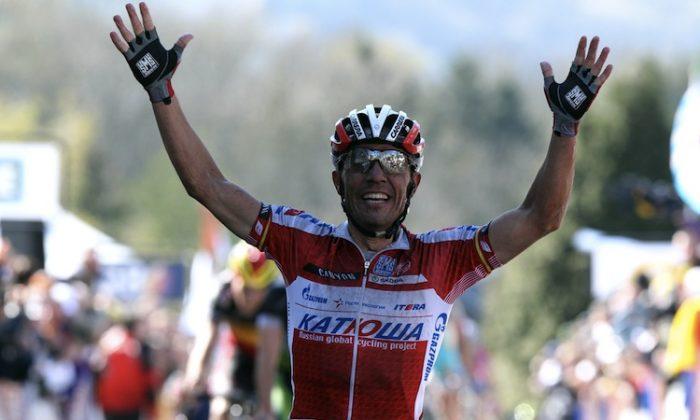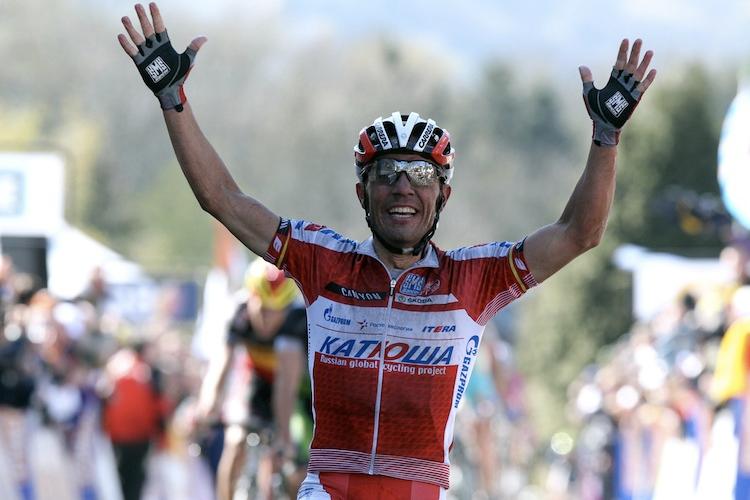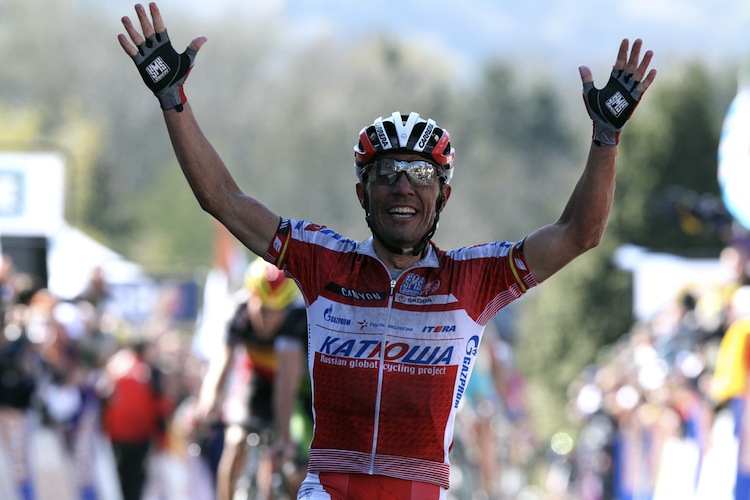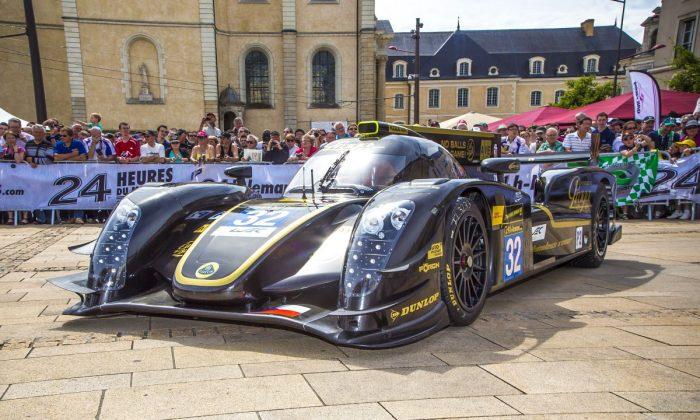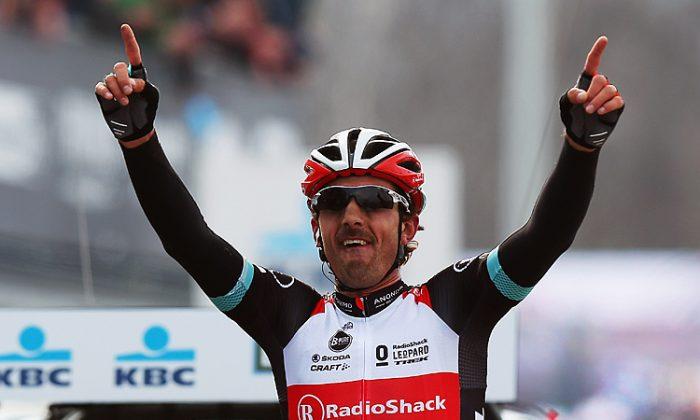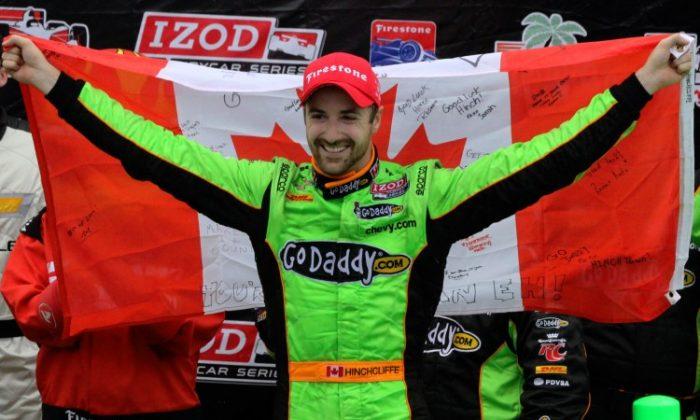Joaquim Rodriguez of Katusha, fresh off two stage wins in the tour of the Basque Country, added another victory to the list with a win up the super-steep Mur de Huy in the 2012 Flèche-Wallonne cycling race.
Rodriguez, nicknamed “Purito,” is a master of the short, extremely steep climbs, and the Mur de Huy is certainly that: 1.3 kilometers long, it has an average gradient of 9.3 and ramps up to 25 percent.
This year’s route took riders up the Huy; once early in the 194-km race, once 31 km from the end, and again for the uphill finish.
Rodriguez waited until the steepest section of the final climb, and attacked. Riders chased him, but none could catch him and he crossed the line pedaling comfortably with a four-second gap.
The victory meant all the more to the 32-year-old rider as he finished second here in 2010 and 2011.
“It’s the best and most incredible victory of my whole career,” Rodriguez said on the Katusha website. “Today is definitely one of the best days of my life. I’ve always been in love with these Classic races, and a victory in these competitions has always been one of my main goals: finally, after many good results, I managed to win. Obviously I have to thank my teammates: all of them did a great job from the beginning to the end.
“It’s true that Mur de Huy was a more suitable final part to my characteristics than Cauberg [the final climb in the Amstel Gold Classic], but I have to admit it was really hard. It looked like an easy victory, but I did a strong effort in order to defeat my rivals.
“Now I can get ready for Liege-Bastogne-Liege with high motivations. I don’t think this victory will change anything, I’m not the only forerunner, there are many strong riders with chances to win. Everything changed from the Amstel Gold Race to Fleche Wallonne and everything can change on Sunday too. So we have to pay a lot of attention and work at our best if we want to take this legendary double.”
Katusha All the Way
In a way, Katusha earned this win; the Russian team, along with Lotto-Belisol, drove the peloton all day long, and particularly at the end, trying to stifle breakaways.
The weather was miserable at the start, cleared for the middle kilometers, and rain came pelting down again shortly before the finish, the last showers were intense but brief; just enough to make sure every rider was thoroughly miserable and the roads dangerously slick for the finish.
After a few abortive attempts, two riders got away 55 km into the race: Dirk Bellemakers of Landbouwkrediet and Anthony Roux of FDJ opened a gap and eventually stretched it to seven minutes. 45 km later Sander Armee of Topsport Vlaanderen-Mercator tried to bridge, but never made it, getting caught with 44 km to go.
A number of small...
A number of small groups tried to escape after this: RadioShack’s Andy Schleck and Katusha’s Yury Trofimov with Astana’s Dmitriy Fofonov joining; a few more failed attempts, and then Giovanni Visconti (Movistar) and Tom Jelte Slagter (Rabobank) made a serious effort. This pair caught the leaders but were themselves caught with 13 km to go.
Katusha continued to drive the peloton, while Movistar’s Vasili Kiryienka and Katusha’s Angel Vicioso attacked. That lasted about three km; then Astana’s Maxim Iglinskiy attacked. The Astana rider was caught, but went again with Garmin-Barracuda’s Ryder Hesjedal. When that didn’t work, Sky’s Lars Petter Nordhaug made a move, joined by Hesjedal.
This attack looked like it might last; it seemed Katusha might not have the firepower left to shut it down. This attack started seven kilometers from the final climb, and opened a gap of 13 seconds by the time the serious ascent started, but Nordhaug was struggling almost immediately. He fell back, fought back, and finally got swallowed up by a chase group including Liquigas’ Vincenzo Nibali, GreenEdge’s Michael Albasini, and BMC’s Philippe Gilbert.
Hesjedal pressed on but halfway up the climb, on the steepest slopes, Rodriguez and Albasini caught him. Then Rodriguez attacked and everyone was fighting for second. Hesjedal finished 21st—the fate of the gambler who didn’t win. Philippe Gilbert took third behind Albasini.
Three Classics: Three Winners?
Flèche-Wallonne is the second of the three “Ardennes Week” Classics: the Amstel Gold on April 15, Flèche-Wallone on April 18, and Liege-Bastogne-Liege, April 22. The difficult one-day races are traditional tests of a cyclist’s abilities: Amstel is long and filled with short medium climbs; Flèche-Wallone is shorter but has some very tough climbs; and Liege-Bastogne-Liege is long and has tough climbs, and also an uphill finish.
Rodriguez finished 24th in the Amstel Gold; it was Astana’s Enrico Gasparotto who timed his final attack perfectly to win on the uphill finish. Last year Philippe Gilbert won all three Ardennes Classics but was sixth in the Amstel and third in Flèche-Wallonne this year. Liege-Bastogne-Liege is a race for very strong riders with good climbing legs: the combination of length (255 km) and climbing could break a pure climber or a simple strong man. Ryder Hesjedal, Jelle Vanendert, perhaps Peter Sagan could be the man of the day in Belgium.
Any rider having an exceptionally good day could come through here; the top 25 finishers in either of the first two Ardennes Classics all have the ability, if they happen to be feeling particularly good.
A final climb in Liege-Bastogne-Liege suits Rodriguez. La Redoute, 30 km from the end, is 2.1 km at an average grade of 8.4 percent but contains 21-percent ramps. This is followed by Roche aux Faucons: 1.5 km at an average 9.9 percent and Côte de Saint-Nicolas, 1.0 km at 11.1 percent. All of these would be well suited to attacks, but if “Purito” could get away on La Redoute the remaining climbs could increase his advantage. The final kilometer at 6.5 percent will sap tired riders without giving real climbers much of an edge over one another. If Rodriguez has a decent lead here, he could take the race.
If Rodriguez is not on top form, the race is wide open.
